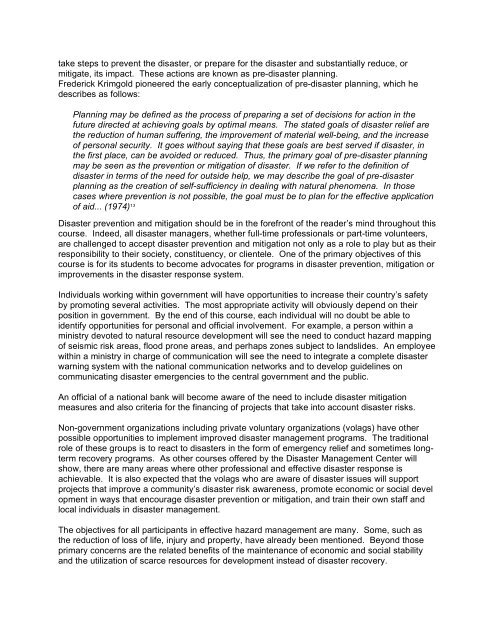Natural Hazards: Causes and Effects - Disaster Management Center ...
Natural Hazards: Causes and Effects - Disaster Management Center ...
Natural Hazards: Causes and Effects - Disaster Management Center ...
Create successful ePaper yourself
Turn your PDF publications into a flip-book with our unique Google optimized e-Paper software.
take steps to prevent the disaster, or prepare for the disaster <strong>and</strong> substantially reduce, or<br />
mitigate, its impact. These actions are known as pre-disaster planning.<br />
Frederick Krimgold pioneered the early conceptualization of pre-disaster planning, which he<br />
describes as follows:<br />
Planning may be defined as the process of preparing a set of decisions for action in the<br />
future directed at achieving goals by optimal means. The stated goals of disaster relief are<br />
the reduction of human suffering, the improvement of material well-being, <strong>and</strong> the increase<br />
of personal security. It goes without saying that these goals are best served if disaster, in<br />
the first place, can be avoided or reduced. Thus, the primary goal of pre-disaster planning<br />
may be seen as the prevention or mitigation of disaster. If we refer to the definition of<br />
disaster in terms of the need for outside help, we may describe the goal of pre-disaster<br />
planning as the creation of self-sufficiency in dealing with natural phenomena. In those<br />
cases where prevention is not possible, the goal must be to plan for the effective application<br />
of aid... (1974) 13<br />
<strong>Disaster</strong> prevention <strong>and</strong> mitigation should be in the forefront of the reader’s mind throughout this<br />
course. Indeed, all disaster managers, whether full-time professionals or part-time volunteers,<br />
are challenged to accept disaster prevention <strong>and</strong> mitigation not only as a role to play but as their<br />
responsibility to their society, constituency, or clientele. One of the primary objectives of this<br />
course is for its students to become advocates for programs in disaster prevention, mitigation or<br />
improvements in the disaster response system.<br />
Individuals working within government will have opportunities to increase their country’s safety<br />
by promoting several activities. The most appropriate activity will obviously depend on their<br />
position in government. By the end of this course, each individual will no doubt be able to<br />
identify opportunities for personal <strong>and</strong> official involvement. For example, a person within a<br />
ministry devoted to natural resource development will see the need to conduct hazard mapping<br />
of seismic risk areas, flood prone areas, <strong>and</strong> perhaps zones subject to l<strong>and</strong>slides. An employee<br />
within a ministry in charge of communication will see the need to integrate a complete disaster<br />
warning system with the national communication networks <strong>and</strong> to develop guidelines on<br />
communicating disaster emergencies to the central government <strong>and</strong> the public.<br />
An official of a national bank will become aware of the need to include disaster mitigation<br />
measures <strong>and</strong> also criteria for the financing of projects that take into account disaster risks.<br />
Non-government organizations including private voluntary organizations (volags) have other<br />
possible opportunities to implement improved disaster management programs. The traditional<br />
role of these groups is to react to disasters in the form of emergency relief <strong>and</strong> sometimes longterm<br />
recovery programs. As other courses offered by the <strong>Disaster</strong> <strong>Management</strong> <strong>Center</strong> will<br />
show, there are many areas where other professional <strong>and</strong> effective disaster response is<br />
achievable. It is also expected that the volags who are aware of disaster issues will support<br />
projects that improve a community’s disaster risk awareness, promote economic or social devel<br />
opment in ways that encourage disaster prevention or mitigation, <strong>and</strong> train their own staff <strong>and</strong><br />
local individuals in disaster management.<br />
The objectives for all participants in effective hazard management are many. Some, such as<br />
the reduction of loss of life, injury <strong>and</strong> property, have already been mentioned. Beyond those<br />
primary concerns are the related benefits of the maintenance of economic <strong>and</strong> social stability<br />
<strong>and</strong> the utilization of scarce resources for development instead of disaster recovery.








